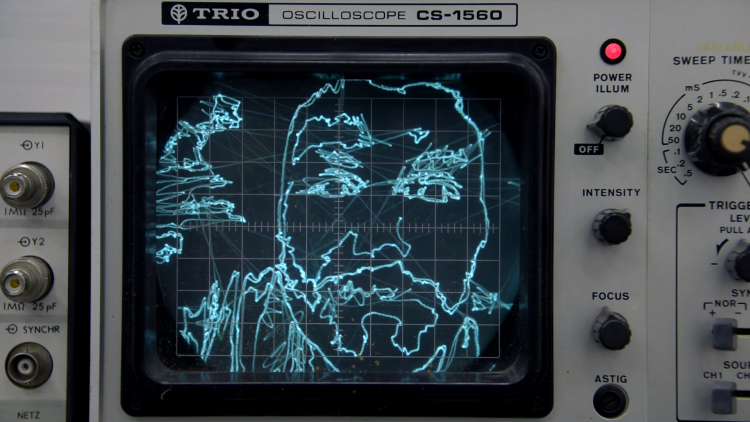Ted Davis: teaching “new and newer media” at NØ School Nevers
Published 16 July 2019 by Dare Pejić
Makery spoke with media artist and designer Ted Davis, who gave a lecture and workshop on the closing day of NØ School Nevers, an international summer school held in Nevers, France on July 1-14, 2019.
Nevers, special report
Ted Davis is a media artist, designer and educator based in Basel, Switzerland. He teaches interaction design and coordinates the UIC/HGK International Master of Design Program at the Basel School of Design HGK FHNW. His work, exhibited internationally, explores design possibilities in “new and newer media”, while specializing in oscilloscopes.

What is your latest project about?
The latest project since December and January is about live coding in the browser using p5.js, this library that’s sort of inspired from Processing. We held a Processing community day in Basel, and we wanted to have live visuals in the evening. Most of us know Processing, and the day was about Processing. I was looking for live coding environments for visuals and didn’t find what I was looking for with Processing or with p5.js, that is, to see the visuals full screen and code on top of it. So I made an interface with browser that enables audio-reactive VJing with this language p5.js.
What did you present and teach at NØ School?
I presented oscilloscope research and this p5 or P5LIVE, the live coding tool. Those are the two projects that have kept me busy in the last year. The workshop was on P5LIVE.
How does your research at Basel Design School HGK relate with your art practice?
I’m primarily teaching, so the research I do is like artistic research for myself, but then it finds its way into what I’m teaching. The P5LIVE tool I used the last semester with my first-year BA students to get them into creative code, and it ended up being a really fast way. It made a difference I could tell, from the previous year, just how quickly they could get into the code and try things out. It took away the hesitations of: “Should I press play?” “Should I run the code?” They just tried things very quickly. Previously, with the oscilloscope studies, that was encouraging, looking away from the computer screen as output for the code. Then I was teaching courses on what are the other ways that we can display our code, between projection, old, or older new media. What are the technologies out there that we could have our code control?
Is the term “new media” now obsolete?
I like to use the term “new and newer media”. That’s what I started calling my experiments a number of years ago when I first started playing with old pen plotters and thermal printers, because all that tech used to be new media. But then there is the new and the newer media. So, it gets newer and newer. So, some people hate the term and don’t use the term new media. But it’s still useful to give people a basic context of what you are talking about. New media throws a certain idea of what it is, then you can get more specific about what aspect of new media you mean.
What do you think future media will look like? Do you see any convergence?
I can imagine, I guess it’s more of a hope, that our future media will be based on a lot of the media that’s already happened, and we could figure out how should we use what happened then for the future. I’m really interested in analog displays, what the CRT does, the oscilloscope has such a special quality compared to this really high retina display that we have. I’m optimistic for the future. Maybe through bio luminescence, bio hybrids we’ll find ways of screen technology that uses less power, offers different quality… At the same time, I’m really curious. We have augmented reality contact lenses. Google glasses didn’t work, but when it’s more embedded, you can have layers. What is that going to mean for how we use the computer that we have in front of us? Some sort of an omni-screen era.
View this post on InstagramNØ SCHOOL NEVERS DAY 12 NØ TALK with @gucci_bagel Alex McLean
A post shared by NØ SCHOOL NEVERS (@noschoolnevers) on
Today is the last day of NØ School. Did it meet your expectations?
It totally exceeded them. I had FOMO for the first week when I was watching it from the Internet. I had a workshop in Basel, so I only joined the second week. Once getting here, it became amazing. NØ School was able to be a network of Ben’s [Benjamin Gaulon, NØ School organizer] experience in the field over the last years, brining all these people and skills together. It was pretty wild to have that intensity each day of different inputs, different technologies, and then the student group. It’s really interesting how one’s own practice, own research within their PhDs and such can work together in a mix—both being a teacher and then sitting with others and getting skills that I was curious about or knew about only from the Internet, and then getting them here, first-hand, from those tool creators.
Do you still get goose bumps after so many years in media, design and coding?
Yes, totally. I still get goose bumps. Every time you touch a piece of equipment or code in a slightly different way that you did before, you get surprised. Each time that surprise happens, there’s still goose bumps. And it’s like: “Oh, that’s exciting!”
More about Ted Davis and NØ School Nevers
